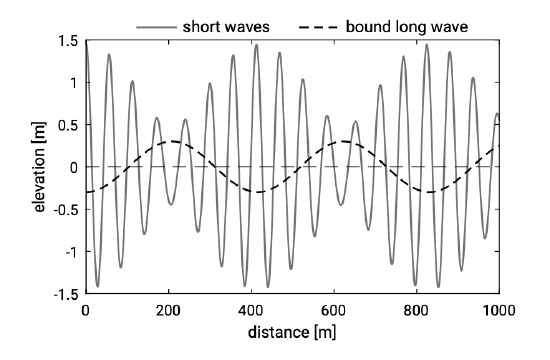5.8.2: Bound long waves and surfbeat
- Page ID
- 16343
The concept of wave radiation stresses and wave induced forces considered in this chapter did not include temporal variations created by individual waves or wave groups, because radiation stress was calculated as the resultant integrated over the wave period and any wave groups. As we have seen in Sect. 3.5.3 waves generally travel in groups of higher and smaller waves. Due to the wave height variation in the groups, the radiation stresses vary as well, being highest under the highest waves. This results in a time-varying set-down in the shoaling zone, with the largest depression under the highest waves. The effect of this is a long wave motion on the wave group scale. The long wave is forced; it has the length and frequency of the group and the phase speed is not that of a free gravity wave but it travels with the group at the wave group speed. This phenomenon is referred to as the bound long wave associated with the group.

For a perfect bound long wave, the phase shift between the long-wave and the short-wave envelope (enveloping the maxima and minima of the individual waves) equals \(-\pi\) (it is \(180^{\circ}\) out of phase with the group meaning that the wave trough of the bound long waves coincides with the maximum of the wave envelope, see Fig. 5.79).
In reality however, it appears that the correlation between the long wave motion and the group is smaller (but still negative as long as we stay offshore from the surf zone), and that it changes into a positive correlation as we enter the surf zone. The change in the correlation indicates that the long waves are no longer moving at the speed of the group. It is said that the bound long wave is released from the group after breaking. As we will see in Ch. 7, the correlation is important for the magnitude and direction of sediment transport by the long wave.
Due to the variations of wave height in a group, wave breaking can occur intermittently within a group for waves that exceed a certain height. This generates a time-varying set-up and therefore oscillations of the water level near the shore. A general name for low frequency water level oscillation near the shore is surf beat. The exact generation mechanisms of surf beat are still uncertain and besides the present explanation, many alternative and sometimes conflicting explanations have been proposed in the literature.
Surf beats occurring near port entrances can have a negative impact on mooring conditions in the harbour basins.


